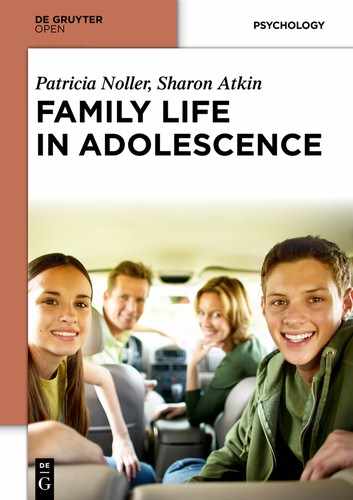Contents
1.2 Stereotypes of Adolescence
1.3 The Chronology of Adolescence
1.3.1 Childhood to Adolescence
1.3.2 Early Adolescence to Late Adolescence
1.5 Community and Political Involvement
2 Theoretical Perspectives on Adolescents in the Family
2.4.1 Family Structure and the Development of Identity
2.4.3 Marcia’s Identity Statuses
2.7 Positive Youth Development
3 Family Environment and Adolescent Development
3.1.1 The Role of Financial Difficulties
3.1.2 Financial Difficulties or Problems with Parenting?
3.1.3 Presence or Absence of Fathers
3.1.4 Instability of Family Structure
3.2 What Makes a Positive Family Environment?
3.2.1 Characteristics of Parent/s
3.2.3.1 Correspondence Between Attachment Styles of Parents And Offspring
3.2.3.2 Impact of Attachment on Parenting Style
3.3.2 Alcoholism and Drug Abuse
3.4 Marital or Relationship Satisfaction, Conflict And Violence
3.4.2 Marital or Relationship Conflict
3.5 Relationships with Extended Family and Community
3.5.2 Neighbourhoods and Communities
3.7 Family Functioning and Discipline
3.7.1.1 Encouragement of Autonomy
3.7.1.2 Cohesion, Flexibility and Communication
3.7.1.4 Level of Control and Monitoring
3.8.2 Sibling Relationships and Adolescent Adjustment
3.10 Implications for Practitioners
4 Communication in Families with Adolescents
4.1 The Changing Nature of Parent-Adolescent Relationships
4.2 Parent-Adolescent Communication
4.2.1 Gender of Parent Differences
4.4 Decision-Making in Families with Adolescents
4.6 Conflict in Families with Adolescents
4.6.1 Identity Styles and Conflict
4.6.2 Gender of Adolescent Differences in Parent-Adolescent Conflict
4.6.4 Positive Aspects of Parent-Adolescent Conflict
4.6.5 Negative Aspects of Parent-Adolescent Conflict
4.8 Communication with Siblings
4.9 Family Relationships and Relationships with Peers
4.10 Technology and Communication
4.11 Culture and Communication
4.13 Implications for Practitioners
5 Adolescents in Divorced and Separated Families
5.1 Residential Arrangements and Adjustment Following Divorce
5.1.1 Residential Arrangements
5.2 Communication About the Divorce
5.2.1 Inappropriate Disclosures by Parents
5.3 Conflict and Children’s Adjustment Following Divorce
5.3.2 Sex Differences in Reactions to Conflict
5.3.3 What Adolescents Say About Their Parents’ Conflict
5.4 Long term Effects of Divorce on Adjustment
5.5 Conflict, the Legal System and Adjustment
5.6 Shared Family Time and Family Resilience Following Divorce
5.7 Racial and Ethnic Differences in Experiencing Parents’ Marital Disruption
5.8 Adolescents’ Management of Relationships with Divorced Parents
5.9 Children’s Perceptions of Their Sibling Relationships Following Divorce
5.9.1 Hostility and Warmth in Sibling Relationships
5.9.2 Explaining Affect-Intense Relationships
5.10 Parental Divorce and Adolescent Problem Behaviour
5.10.1 Divorce-Proneness and Adolescent Problem Behaviour
5.10.2 Environmental or Genetic Factors?
5.10.3 Parental Divorce and Offspring Mental Health
5.10.3.1 Divorce and Long-Term Depression
5.10.4 Does Divorce Cause These Problems?
5.11 Divorce and Romantic Relationships of Offspring
5.14 Implications for Practitioners
6 The Family and Adolescent Issues
6.1 Positive Youth Development
6.2.1 Alcohol and Illegal Drugs
6.2.2.1 Risk and Protective Factors for Smoking
6.2.3.2 Sex Education and Contraception
6.2.3.3 Pregnancy and Childbearing
6.2.4 Conduct Disorder, Antisocial Behaviour, Aggression and Delinquency
6.2.4.2 Aggression and Antisocial Behaviour
6.3.1.1 Effects of Parental Depression
6.3.1.2 Coercive Family Processes
6.3.1.3 Supportive and Facilitative Interactions
6.3.1.4 Life Skills and Depression
6.5 Implications for Practitioners
7.1 Emerging Adulthood, Delayed Transitions and Leaving Home
7.2 Family Structure and Leaving Home
7.3 Family Relationships and Leaving Home
7.5 Leaving Home for the Military
7.6 Leaving Home to Marry or Cohabit
7.11 Some Implications for Practitioners
8 Risk and Resilience in Adolescence
8.1 Characteristics of Resilience
8.2 Characteristics of Resilient Adolescents
8.3 Resilience and Mental Illness
8.4 Individual Factors and Resilience
8.5 Family Factors in Resilience
8.5.2 An Emotionally Warm Atmosphere
8.5.4 Provision of Encouragement and Support
8.5.5 Adequate Rules and Supervision
8.5.6 Sex Differences in Resilience
8.6 Resilience and Emotion Regulation
8.7 Resilience Against Depression
8.8 Self-esteem, Resilience and Protection from Risky Behaviour
8.9 The Importance of the Family Environment
8.10 African-American Youth: A Case Study
8.11 Temperament and Resilience
